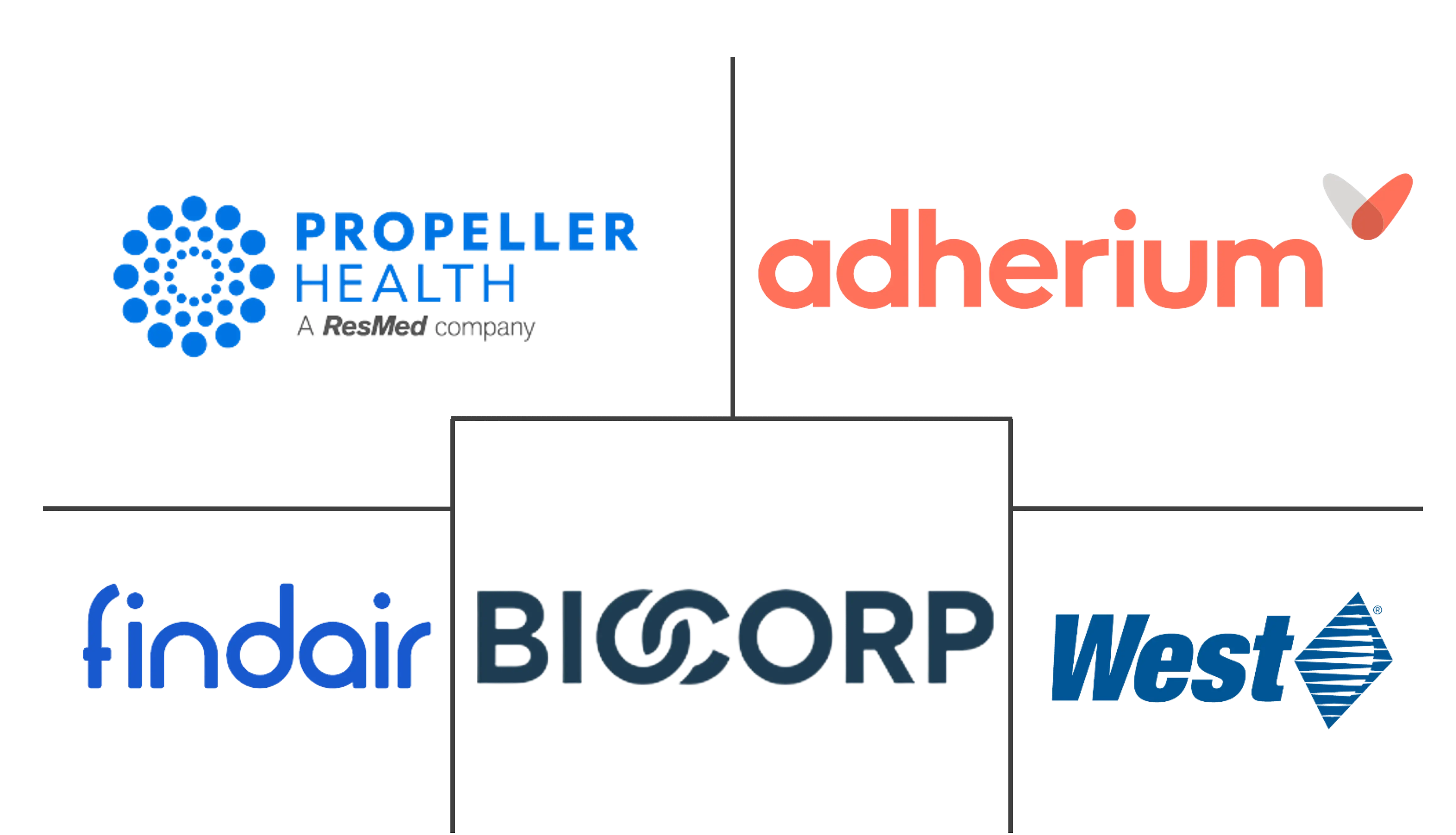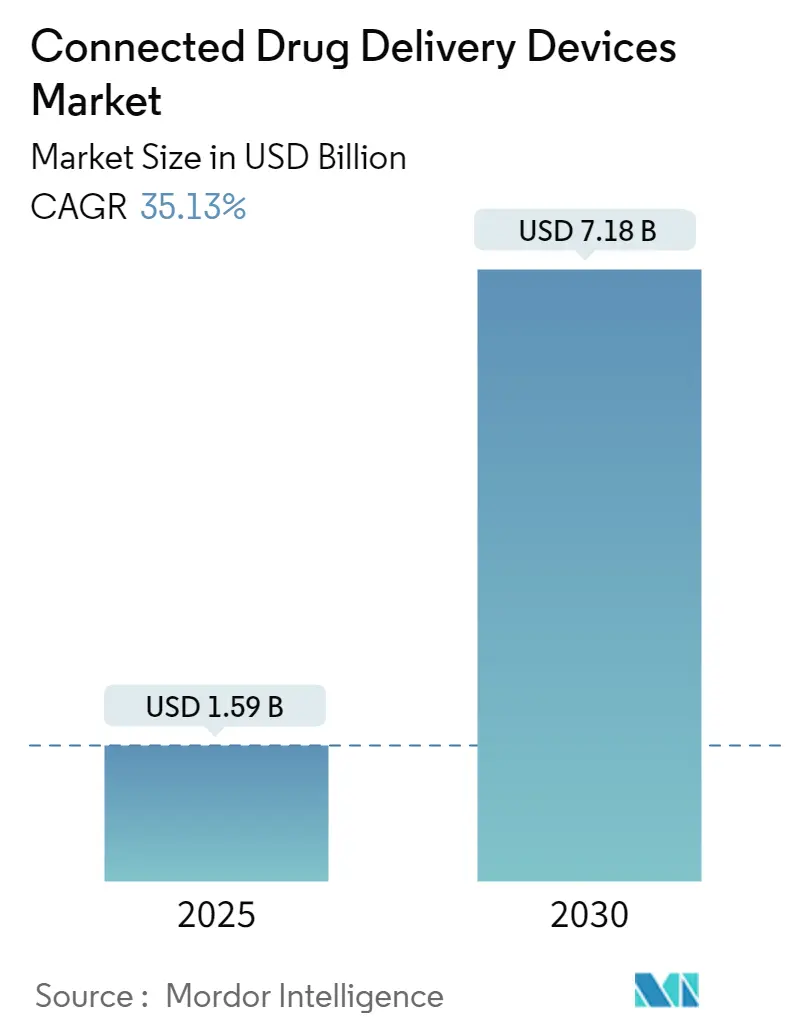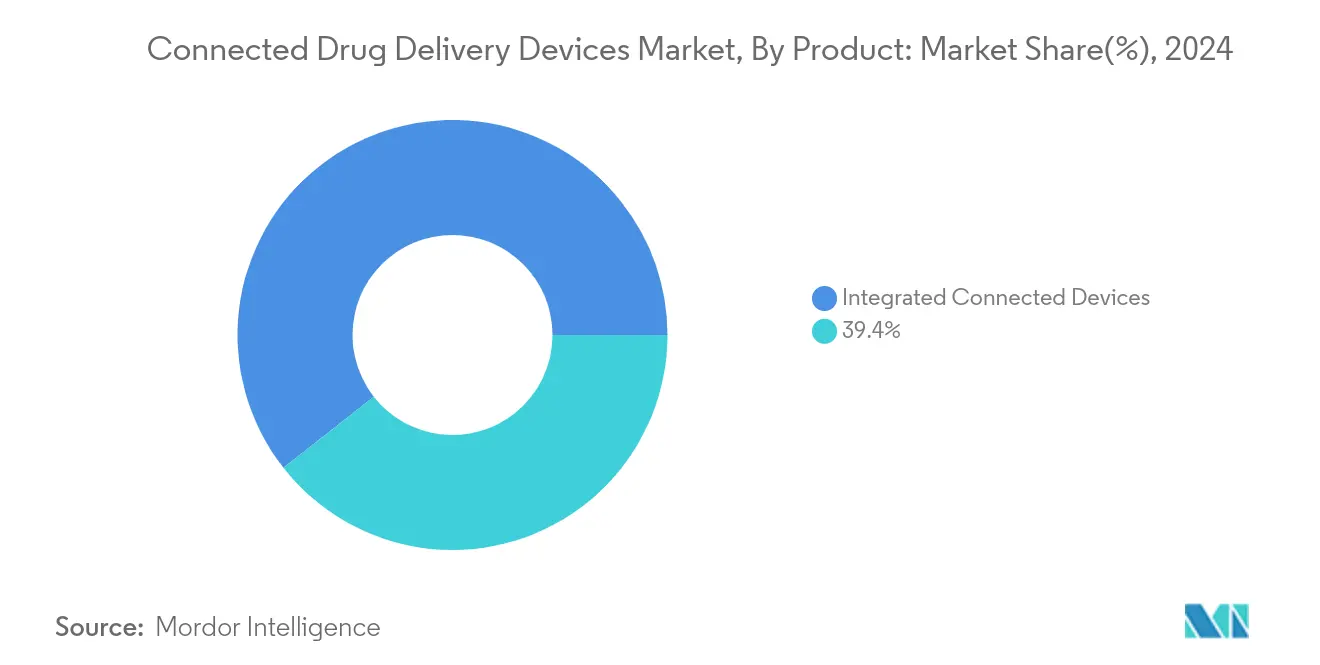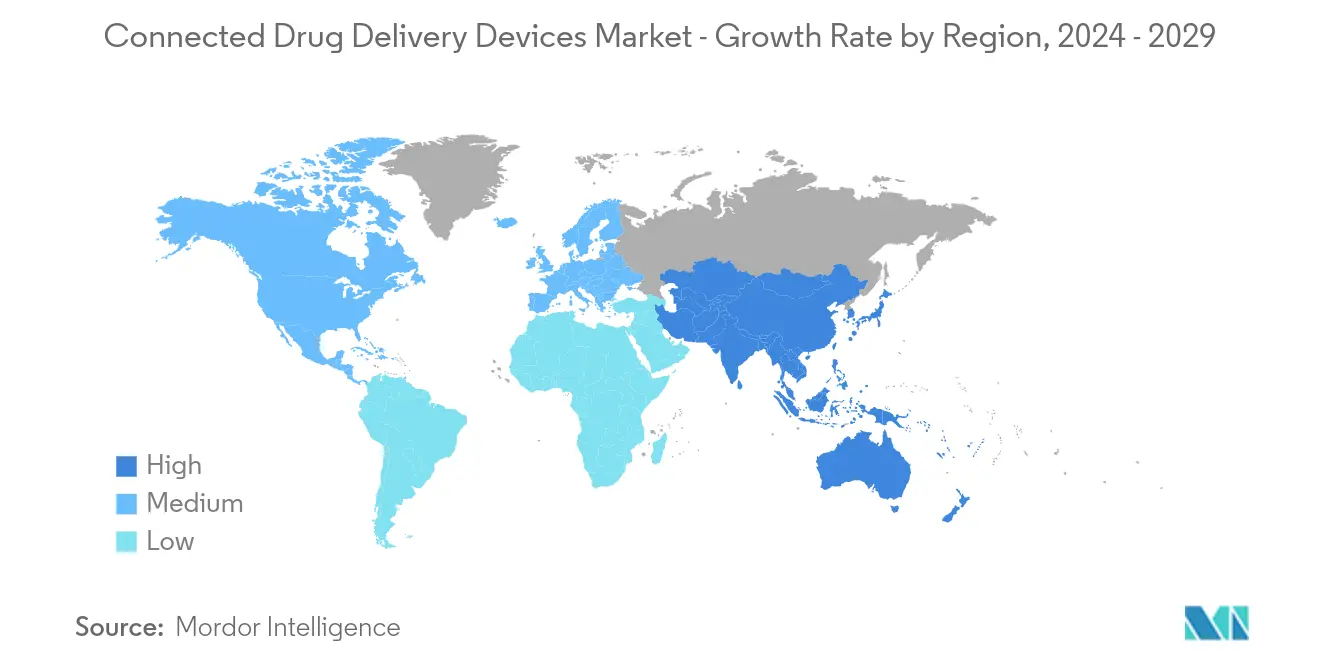Global Connected Drug Delivery Devices Market
The Connected Drug Delivery Devices Market size is estimated at USD 1.59 billion in 2025, and is expected to reach USD 7.18 billion by 2030, at a CAGR of 35.13% during the forecast period (2025-2030). As cases of chronic diseases like diabetes, asthma, and cardiovascular conditions rise, the demand for these devices grows, thanks to their ability for real-time monitoring and accurate drug delivery. Moreover, advancements in Internet of Things (IoT) technology have streamlined the development of devices capable of collecting, transmitting, and analyzing patient data. Improved connectivity with smartphones and tablets has facilitated more personalized and timely medical interventions. With the healthcare sector's shift towards precision medicine, there's a surging demand for devices that can administer personalized doses. These devices rely on real-time data of patients, including metrics like glucose levels and respiratory rates. This trend is not only expanding the horizons of the globally connected drug delivery devices industry but also attracting attention from both emerging entrants and established players.
| Study Period | 2019 - 2030 |
| Market Size (2025) | USD 1.59 Billion |
| Market Size (2030) | USD 7.18 Billion |
| CAGR (2025 - 2030) | 35.13 % |
| Fastest Growing Market | Asia Pacific |
| Largest Market | North America |
Major Players
*Disclaimer: Major Players sorted in no particular order |

Industry Dynamics
As the prevalence of chronic diseases such as Chronic Obstructive Pulmonary Disease (COPD), diabetes and surgeries rise among the elderly, medication adherence is projected to improve. Research highlights factors such as side effects, medication costs, dosing frequency, and administration routes significantly influence medication adherence. However, when the target population is informed about medication adherence and its benefits, there is a potential reduction in mortality and morbidity risks. Therefore, as chronic diseases become more prevalent, there is a growing demand for advanced medication delivery technologies that enhance adherence benefits.
Moreover, empowered patients tend to be more motivated in managing their diseases and sticking to their prescribed medications. Consequently, numerous government and private entities have initiated medication adherence awareness programs. These efforts are significantly boosting awareness about the importance of timely adherence to prescribed therapies and medications. As a result, there is a growing opportunity for the market players, established as well as new ones.
Substantial investments are pouring into the digital health industry as companies prioritize the creation of integrated solutions. This influx of funding not only fuels innovation but also paves the way for the emergence of new connected drug delivery devices. As a result, rising investments in digital health are poised to fuel global market growth in the years ahead.
On the other hand, connected drug delivery devices, equipped with advanced hardware and software, come at a premium compared to their traditional counterparts. Furthermore, the necessity for a strong IT infrastructure and consistent connectivity further inflates these costs. This financial barrier of the connected drug delivery devices industry could hinder widespread adoption, especially in areas with constrained healthcare budgets.
Connected Drug Delivery Devices Market Report Coverage
Overview of Market Segments Covered:

In 2024, connected inhaler devices are expected to dominate the integrated connected devices segment, capturing a significant 61.77% market share. Market research indicates that this segment will grow to an estimated USD 1.99 billion by 2029. Digital self-management tools have the potential to enhance clinical outcomes and cut asthma attacks by half. For instance, as per the study published in Primary Care and Respiratory Medicine in May 2023, smart inhalers, through smartphone applications, provide diverse functionalities. These include sending reminders and motivational messages, offering real-time personalized feedback on usage and inhaler technique, and monitoring asthma symptoms. The article further highlighted that these add-on medical devices can assist healthcare professionals (HCPs) in offering guided self-management, empowering patients to adeptly handle their chronic diseases daily. Hence, the likely benefits of the connected inhaler devices in asthma management are likely to create growing demand for smart inhalers are add-on medical devices in the coming years. Moreover, the introduction of these devices highlights technological advancements, which are anticipated to drive growth in the segment. For instance, in July 2023, Teva Pharmaceuticals Industries Ltd introduced a digitally enabled inhaler in the United Kingdom, marking the device's debut in the European market. This inhaler is designed for patients suffering from asthma and chronic obstructive pulmonary disorder (COPD). Owing to above lisetd factors, the connected inhaler devices segment of the industry is expected to propel in the forecast period.
The connected drug delivery devices market is segmented by product, technology, application, and end user. By product, the market is segmented into connected sensors, and integrated connected devices. The connected sensors are further segmented into connected inhaler sensors and connectable injection sensors. The integrated connected devices are further segmented into connected inhaler devices and connected injection devices. By technology, the market is segmented into bluetooth, near-field communication (NFC), and other technologies. By application, the market is segmented into asthma, COPD, diabetes management, and other applications. By end user, the market is segmented into healthcare providers, and homecare. The demand for real-time monitoring and data sharing, enabling better management of chronic conditions through easy smartphone connectivity is likely to augment the growth of the Bluetooth segment under the technology category of the connected drug delivery devices industry.
Regional Market Scope of this Report:
In 2024, North America is expected to dominate the market, capturing a significant 44.65% of global connected drug delivery devices market share. Projections indicate that this North America market value will grow to an estimated USD 2.33 billion by 2029, witnessing significant growth. North America's growing adoption of telehealth, mHealth services, and digital healthcare applications is set to drive market growth. For instance, in March 2022, Respira Labs, a respiratory healthcare tech business based in the United States, released Sylvee, an AI-powered wearable lung monitor that employs acoustic resonance to assess lung function and identify variations in lung air volume. It can aid in the early detection and treatment of COPD, and asthma. Further, as per the 2022 Canadian Interoperability Landscape: A Survey of Clinicians, over 4 in 5 (82%) report using electronic system(s) to document patient information, with most using electronic systems only (82%) vs. a hybrid system of electronic and paper documentation (10%) or paper records only (7%). Consequently, the rising adoption of electronic systems delivering medication alerts and follow-up instructions and other advanced technologies is projected to drive North America market growth during the forecast period.

By geography, the global market is segmented into North America (United States, Canada, Mexico), Europe (Germany, United Kingdom, France, Italy, Spain, Rest of Europe), Asia-Pacific (China, Japan, India, Australia, South Korea, Rest of Asia-Pacific), Middle East and Africa (GCC, South Africa, Rest of Middle East and Africa), and South America (Brazil, Argentina, Rest of South America). Asia Pacific, with its expanding digital infrastructure, increasing healthcare access, and rising prevalence of chronic diseases, presents substantial growth opportunities for the connected drug delivery devices industry. Furthermore, supportive government initiatives promoting health tech adoption bolster this potential. While emerging regions like Asia Pacific and middle east show promise, developed regions are projected to maintain a significant connected drug delivery devices market growth in the coming years. Additionally, the studied market in East Africa is being propelled by the rising adoption of mobile health solutions, enhanced management of chronic diseases, and advancements in healthcare infrastructure.
Competitive Landscape and Ecosystem Analysis:
Some of the key players in the connected drug delivery devices market are ResMed (Propeller Health), Findair Sp. z o. o., BIO CORP, Teva Pharmaceuticals Industries Ltd, Adherium Limited, West Pharmaceutical Services Inc., Aptar Pharma, Ypsomed AG, Phillips-Medisize, among others. Key market players engage in strategic collaborations, acquisitions, and product approvals and launches to maintain their competitive edge. For instance, in October 2024, Insulcloud SL, a Spain-based technological healthcare solution company, received FDA clearance for its bluetooth-enabled medical device, Insulclock CAP. This device converts standard disposable insulin pens into advanced tools for managing diabetes. It offers both visual and audible alerts, enabling users to fine-tune their insulin therapy. The company asserts that its device guarantees the correct usage of insulin pens, thereby boosting safety and control. The connected drug delivery devices sector is fragmented in nature in the context of the competitive landscape.
Connected Drug Delivery Devices Market Report Scope
| By Product | ||||
| ||||
|
| By Technology | |
| Bluetooth | |
| Near-field communication (NFC) | |
| Other Technologies |
| By End User | |
| Healthcare Providers | |
| Homecare |
| By Geography | ||||||||
| ||||||||
| ||||||||
| ||||||||
| ||||||||
|
Industry Developments
- In October 2024, Modivcare Inc., a prominent player in technology-driven healthcare services, through its subsidiaries, Valued Relationships, Inc. (VRI) and Higi Care, LLC, Modivcare has teamed up with Tenovi, a pioneer in cellular-connected remote monitoring. Together, they are set to introduce Adherium’s Hailie Smart inhalers, aiming to elevate care for patients grappling with chronic respiratory conditions.
- In September 2024, SHL Medical, a trailblazer in self-injection solutions, introduces Elexy, a versatile electromechanical drug delivery device designed to enhance digital therapeutics and accommodate a diverse array of specialty formulations. With cellular and Bluetooth connectivity, the Elexy device enables the thorough collection of data concerning drug, container, and device usage.
- In June 2024, Aptar Digital Health, a global frontrunner in digital health solutions, has teamed up with SHL Medical, a premier provider of cutting-edge drug delivery systems, including autoinjectors and pen injectors. This partnership aims to enhance SHL Medical's connected device technologies by incorporating Aptar Digital Health's SaMD platform, offering holistic solutions for patients undergoing injectable therapies.
- In October 2023, SHL Medical, a frontrunner in advanced technologies for autoinjectors and specialty drug delivery systems, unveiled a new webpage for its Molly Connected Cap. This smart, retrofittable add-on enhances the market-proven Molly modular platform autoinjector.
Connected Drug Delivery Devices Market Research FAQs
How big is the Connected Drug Delivery Devices Market?
The Connected Drug Delivery Devices Market size is expected to reach USD 1.59 billion in 2025 and grow at a CAGR of 35.13% to reach USD 5.30 billion by 2030..
What is the current Connected Drug Delivery Devices Market size?
In 2025, the Connected Drug Delivery Devices Market size is expected to reach USD 1.59 billion.
Who are the key players in Connected Drug Delivery Devices Market?
West Pharmaceutical Services, Inc., FindAir, Adherium Limited, BIOCORP and Propeller Health (ResMed Inc.) are the major companies operating in the Connected Drug Delivery Devices Market.
Which is the fastest growing region in Connected Drug Delivery Devices Market?
Asia Pacific is estimated to grow at the highest CAGR over the forecast period (2025-2030).
Which region has the biggest share in Connected Drug Delivery Devices Market?
In 2025, the North America accounts for the largest market share in Connected Drug Delivery Devices Market.
What years does this Connected Drug Delivery Devices Market cover, and what was the market size in 2024?
In 2024, the Connected Drug Delivery Devices Market size was estimated at USD 1.18 billion. The report covers the Connected Drug Delivery Devices Market historical market size for years: 2019, 2020, 2021, 2022, 2023 and 2024. The report also forecasts the Connected Drug Delivery Devices Market size for years: 2025, 2025, 2026, 2027, 2028, 2029 and 2030..
What are the reimbursement challenges for connected drug delivery devices?
The reimbursement challenges for connected drug delivery devices are a) Potential for limited coverage by insurance companies b) The need for demonstrating cost-effectiveness



